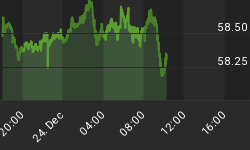Below is an extract from a commentary originally posted at www.speculative-investor.com on 17th July, 2008.
In an article posted earlier this week, Mike "Mish" Shedlock weighed in on the TMS vs. M3 discussion. Mish's article supports our view that TMS (the "True Money Supply" developed by Murray Rothbard and Joseph Salerno) is a more appropriate measure of money supply than M3, although he prefers a measure called "M Prime". The main difference between TMS and M Prime is that TMS includes savings deposits whereas M Prime does not.
Our view is that savings deposits must be included in any measure of the total money supply, for the reasons spelled out on pages 2 and 3 of Joseph Salerno's article at http://www.mises.org/journals/aen/aen6_4_1.pdf. According to Salerno:
"Savings deposits, whether at commercial banks or thrift institutions are economically indistinguishable from demand deposits and are therefore included in the TMS. Both demand and savings deposits are federally insured under the same conditions and, consequently, both represent instantly cashable, par value claims to the general medium of exchange. The objection that claims on dollars held in savings deposits typically do not circulate in exchange (although certified or cashier's checks may be readily drawn against such deposits and are certainly generally acceptable in exchange), while not unimportant for some purposes of analysis, is here beside the point. The essential, economic point is that some or all of the dollars accumulated in, e.g., passbook savings accounts are effectively withdrawable on demand by depositors in the form of spendable cash. In addition, savings deposits are at all times transferable, dollar for dollar, into "transactions" accounts such as demand deposits or NOW accounts."
The other area of disagreement between ourselves and Mish lies in the definition of inflation and deflation. Mish asserts that inflation is an expansion in the total supply of money AND credit, with deflation being the opposite (a contraction in the total supply of money AND credit). Our view, however, is that credit should be excluded from the definition. To be specific, we define inflation as an increase in the total supply of money, with deflation being the opposite condition.
There are many cases in which an increase in the supply of credit will lead to an increase in the supply of money. For example, most bank loans result in the creation of new deposit currency. To be more specific, when a bank makes a loan it doesn't transfer part of its existing deposit base to the borrower; rather, it creates new money "out of thin air" and thus alters the value of all existing currency units. However, not all increases in credit result in the creation of new money. For example, when Bill lends money to his friend Bob there is an increase in the total amount of credit in the economy, but the only thing that has happened in this situation is that purchasing power has been temporarily transferred from Bill to Bob. The Bill-Bob transaction affects neither the supply nor the value of existing currency units and is therefore not inflationary.
Similarly, a decrease in the supply of credit could lead to a decrease in the supply of money, but credit contraction is not, in and of itself, deflationary. For example, when a bank suffers loan losses the immediate result is a contraction of credit, but not a reduction in the supply of money. This is because the money that was created when the loans were made still exists after the loans fail. In this situation, however, the bank's ability to make FUTURE loans may be impaired by the loan losses, meaning that there could be less money-supply growth in the future.
Loan losses are, in effect, investment losses, and investment losses are not deflationary per se. Investment losses can LEAD to deflation by impairing the economy-wide ability to lend/borrow new money into existence, but we shouldn't assume that large investment losses within the banking system -- and the resultant credit contraction -- will NECESSARILY lead to deflation. The main reason we shouldn't make this assumption is that the government will ALWAYS be able to borrow and the central bank will ALWAYS be able to lend. For example, if it chose to do so the US Federal Government could borrow 10 trillion new dollars into existence tomorrow by simply issuing $10 trillion of bonds to the Fed.
By defining inflation/deflation in terms of only money-supply changes we incorporate the changes in the supply of credit that LEAD to changes in the supply of money, but not the many changes in the supply of credit that have no effect on the supply of money and, therefore, no long-term effect on money purchasing power.
Currently, TMS's year-over-year rate of increase is around 4.5%, so SOMEONE is borrowing/lending enough new money into existence to offset the effects of whatever credit contraction is occurring. There is currently inflation in the US, albeit at a much slower rate than occurred during the first half of this decade.
Our view is that the US inflation rate (money-supply growth rate) is more likely to accelerate than decelerate over the coming two years because the economic downturn will prompt the US Government to increase the pace at which it borrows new money into existence.
We aren't offering a free trial subscription at this time, but free samples of our work (excerpts from our regular commentaries) can be viewed at: http://www.speculative-investor.com/new/freesamples.html.















